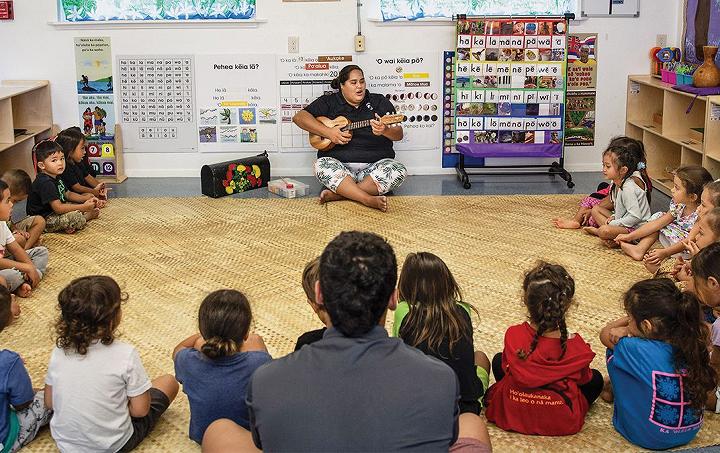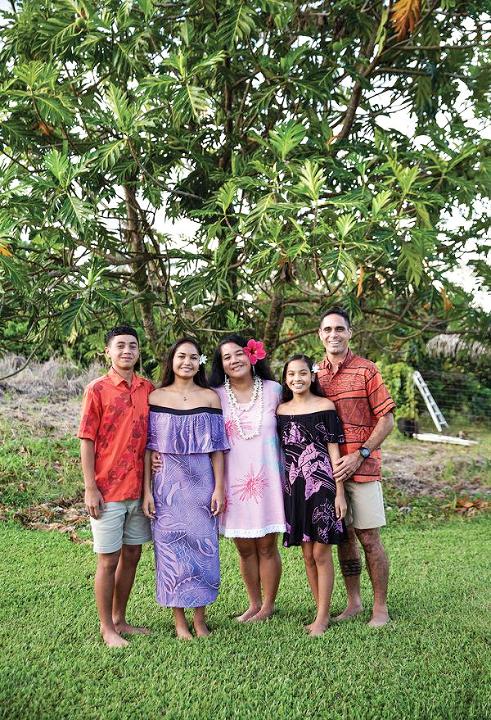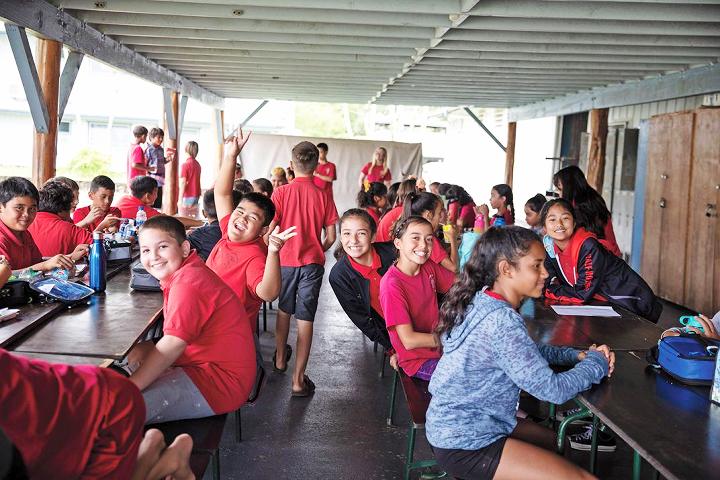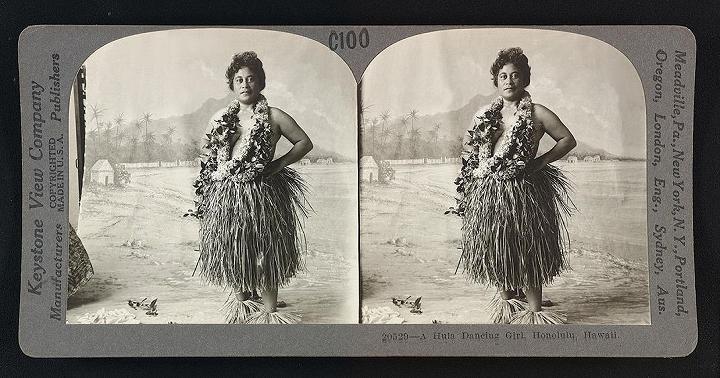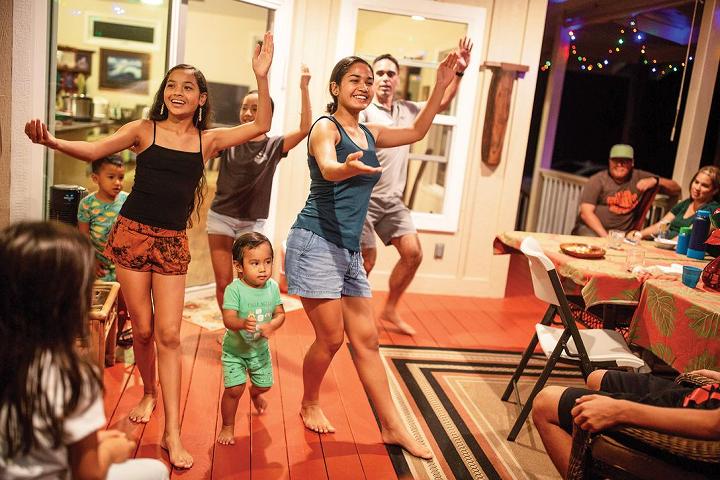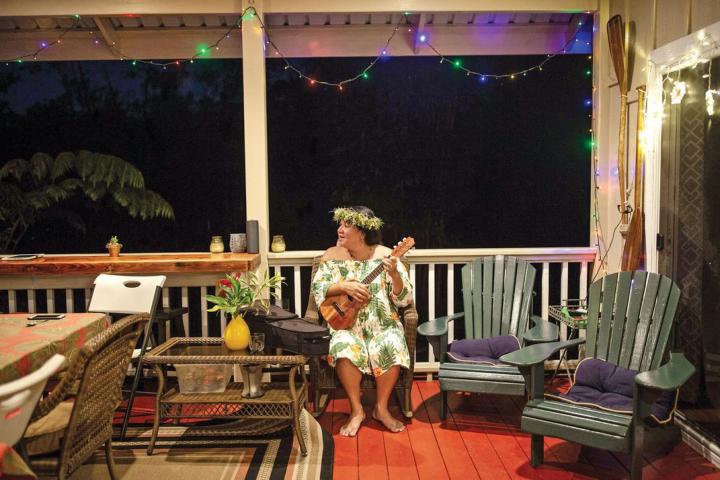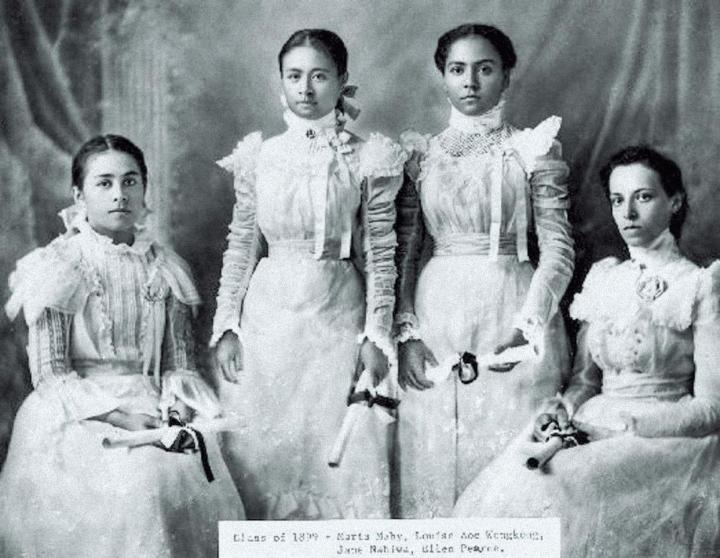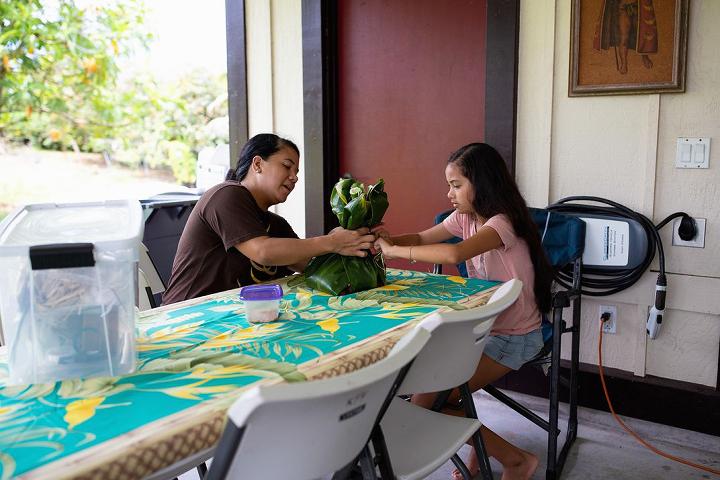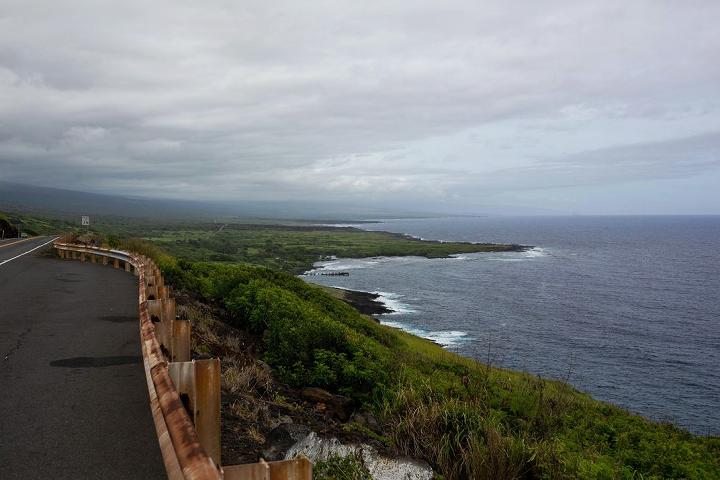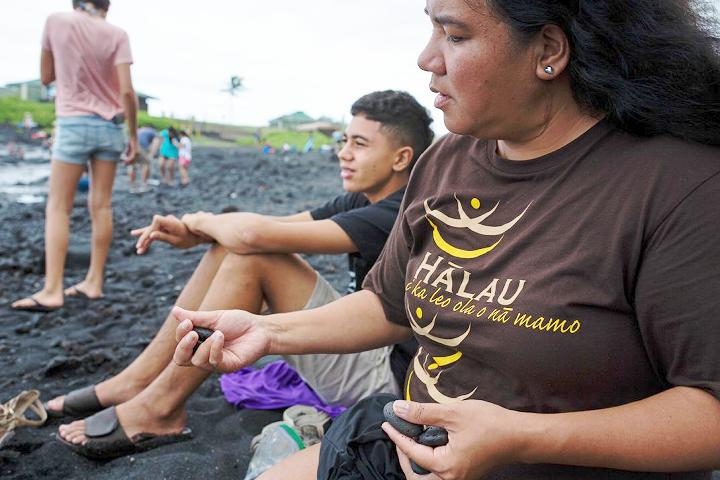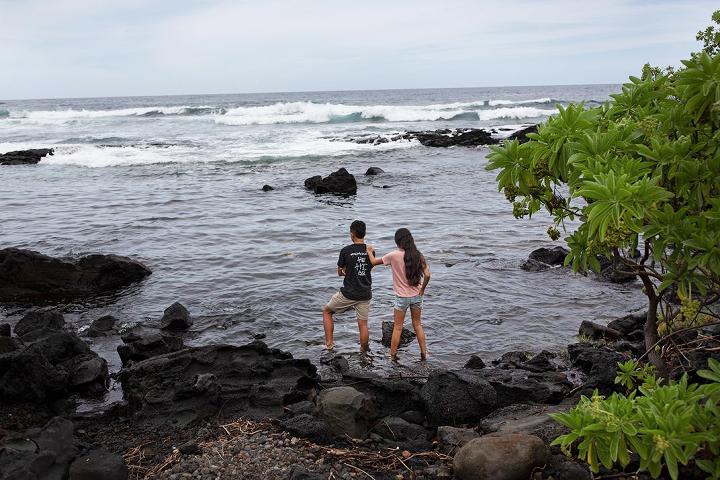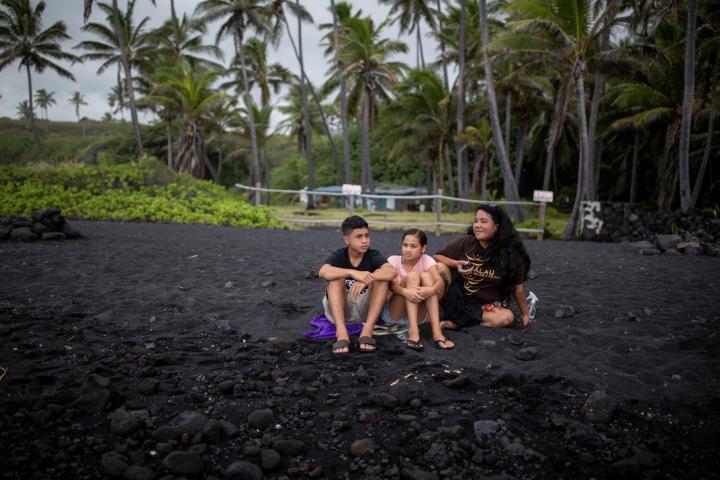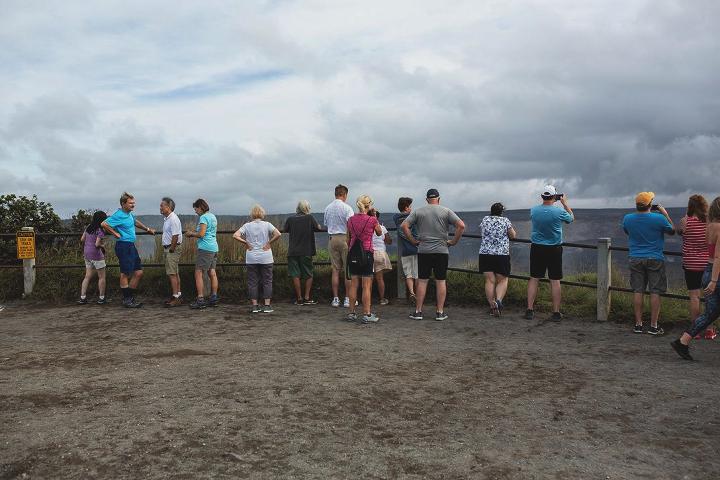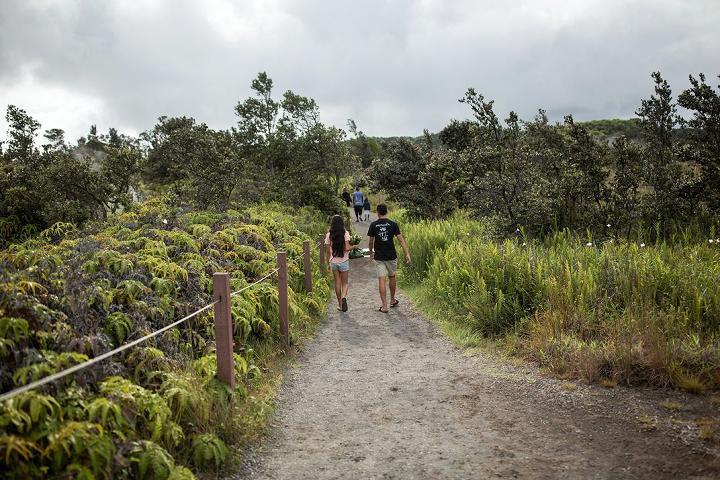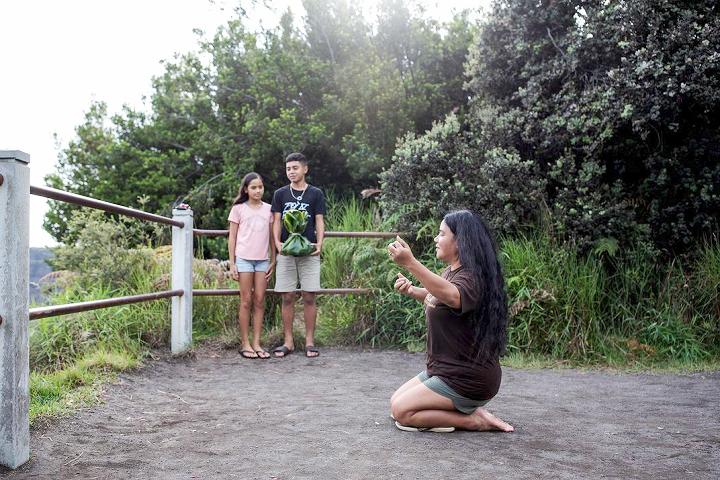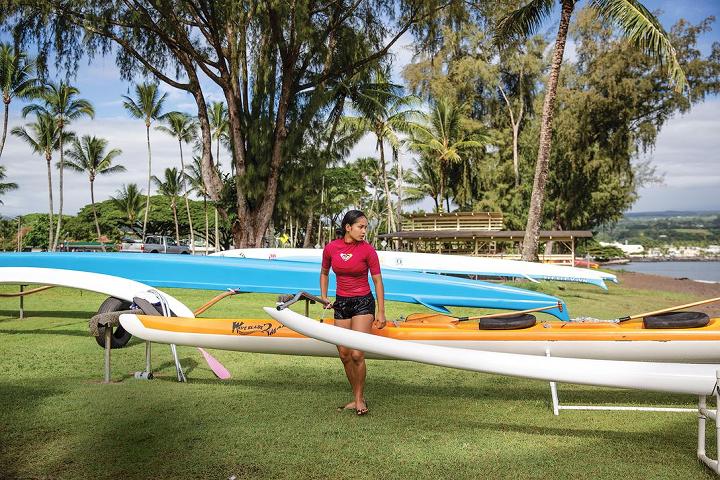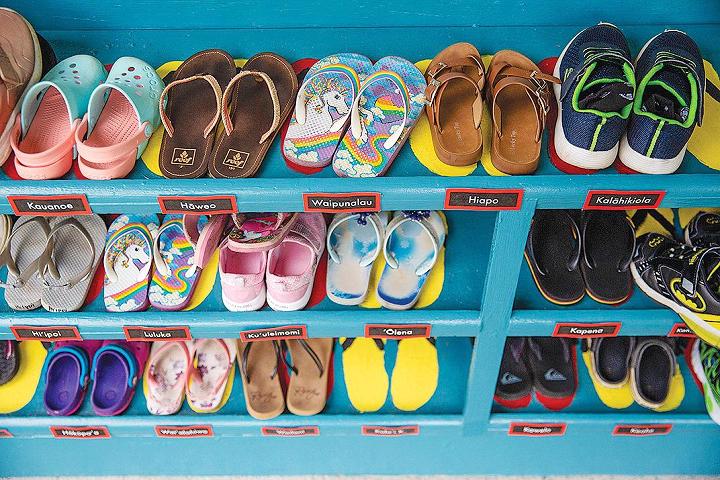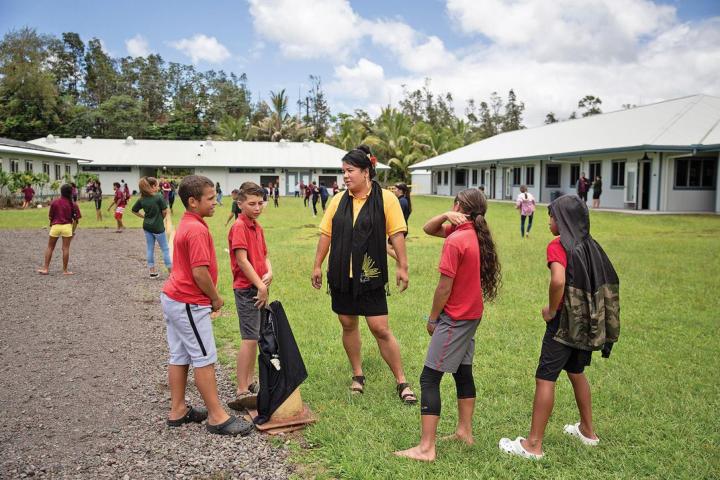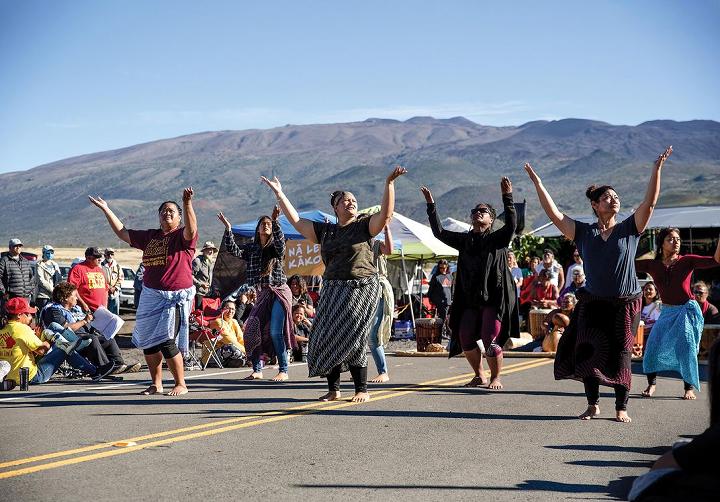 |
Canku Ota
|
 |
|
(Many Paths)
|
||
|
An Online Newsletter
Celebrating Native America
|
||
|
NovemBER 2020 - Volume
18 Number 11
|
||
|
|
||
|
THE INSPIRING QUEST
TO REVIVE THE HAWAIIAN LANGUAGE
|
||
|
by Lia Wong; Photographs
by Daniella Zalcman - Smithsonian Magazine
|
||
|
A determined couple
and their children are sparking the renewal of a long-suppressed
part of their ancestors' culture
Pelehonuamea Suganuma and Kekoa Harman were bright-eyed high schoolers in Honolulu when they first crossed paths, in the 1990s. The two were paired for a performance—a ho'ike, as such shows are known in Hawaiian. Both teenagers had a passion for hula and mele (Hawaiian songs and chants), and they liked performing at the school they'd chosen to attend—Kamehameha High School, part of a 133-year-old private network that gave admissions preference to students of Hawaiian Polynesian ancestry. Still, one part of Hawaiian culture remained frustratingly out of reach for Pele and Kekoa: the language.
Over many generations, the native tongue of the islands had been systematically eliminated from everyday life, and even the Kamehameha Schools weren't able to bring it back. Part of it was a lack of interest—students seemed to prefer learning Japanese, Spanish or French. But more important, Hawaii's educators generally hadn't yet figured out how to teach Hawaiian vocabulary and grammar, or give eager youngsters like Pele and Kekoa opportunities to immerse themselves in Hawaiian speech. A few years later, Pele and Kekoa found themselves together again. Both of them enrolled in a brand-new Hawaiian language program at the University of Hawaii at Hilo. The two former schoolmates became part of a pioneering cohort that was innovating ways to bring Hawaiian back to life. They helped develop some of the first truly successful Hawaiian language programs throughout the state's islands. Along the way, they started dating, got married and had four children, and raised them to speak fluent Hawaiian. Today, Pele teaches at a Hawaiian-language K-12 school and Kekoa teaches Hawaiian language and culture at the college they both attended. At home, their family speaks almost exclusively Hawaiian. The Harmans are proud of the revival they helped carry out in just one generation. But Unesco still lists the language as critically endangered, and there's a long way to go before it's spoken again as a part of everyday life. "There's a false sense of security sometimes," says Pele, "that our language is coming back."
The Hawaiian archipelago—a string of islands born from volcanic activity—was untouched by humans for millions of years. Polynesian navigators discovered it as early as A.D. 400, and by the year 1200, their descendants had organized themselves into settlements called ahupua'a. The first colonizers arrived in the late 1700s, led by Capt. James Cook, who'd set out on behalf of the British Empire to find a northwest passage between the Atlantic and Pacific oceans. These explorers were soon followed by Americans—many of them Protestant missionaries—who settled the islands in large numbers throughout the 19th century. As part of their efforts to convert Hawaiians to Christianity, missionaries needed to teach them how to read the Bible in their native tongue. And that meant introducing palapala—the written word.
For centuries, Hawaiian had been an oral tongue—one steeped in mo'olelo (story, legend, history). But after missionaries helped create a written version of the language, the local people took to it. They established more than 100 Hawaiian-language newspapers, according to some records. By 1834, more than 90 percent of Hawaiians were literate—up from virtually zero just 14 years earlier. Yet these strides in Hawaiian literacy were soon overtaken by efforts to erase Hawaiian culture altogether. American tycoons had also come to the islands, planting lucrative crops like sugar cane and coffee. To work the fields, they brought in foreigners—especially from Japan, China and the Philippines. (By 1896, people of Japanese descent made up roughly a quarter of Hawaii's population.) A new social and political hierarchy arose, largely with white Americans at the top. These outsiders helped to phase out the Hawaiian system of governance. They replaced traditional foods like taro with rice and imported wheat. They started issuing fines for performing hula, the ancient Hawaiian form of dance and expression. And as the 19th century was winding down, the Americans overthrew Queen Lili'uokalani, Hawaii's last monarch. They annexed the archipelago as a territory in 1898.
By the time Hawaii became a state, in 1959, fewer than 2,000 people could speak Hawaiian fluently. Most of them were elderly; very few were children. The language seemed on the brink of being forgotten.
But there were still people left who remembered. Both Pele and Kekoa were close to their great-grandmothers — women born in the early 1900s, who spoke some Hawaiian, even though they were raised to think of their mother tongue as inferior to English. The great-grandmothers were the last members of each family to retain any fluency. Pele's and Kekoa's parents were the first generation to speak no Hawaiian at all. Kekoa grew up on Maui—an island named after a demigod who's credited in Hawaiian tradition with pulling the entire archipelago up from the ocean floor. When Kekoa was a kid, his grandmother, who passed away a few years ago, used to take him to Hawaiian musical and hula performances. She'd make leis for tourist-targeted luaus, and he'd help her gather and string the flower garlands. "I loved going to those events," Kekoa says. "They fostered a sense of 'It's beautiful. It's fun. I want to be around that.'" Outside of these excursions, he lacked an outlet. He was never drawn to sports or other conventional activities foisted on American boys.
As Kekoa approached his teens, his parents gave him the option of becoming a boarder at Kamehameha Schools' main campus—roughly a hundred miles and several sea channels northwest of Maui, on the island of Oahu. Moving away from home isn't easy for any 13-year-old—not least for a Hawaiian whose life is defined by family, or 'ohana. But Kekoa went. Pele was drawn to Kamehameha Schools for similar reasons. One of her grandmothers was Mary Kawena Pukui, co-author of the Hawaiian Dictionary, the standard reference for the Hawaiian language. Her grandmother had dedicated her life to the study and preservation of Hawaiian culture—yet she was haunted by what Pele calls "the trauma and disconnect" of forced assimilation. Seeing her grandmother wrestle with this inner conflict made Pele hungry to "do Hawaiian things in a school setting." Kekoa graduated from high school in 1995. He spent a year at college in Puget Sound, Washington, then transferred to the University of Hawaii at Hilo. Pele, who graduated from high school in 1997, ended up at the same campus around the same time. As it happened, 1997 was the year the Hawaiian legislature mandated a new program at the Hilo campus. It was called Ka Haka 'Ula O Ke'elikolani, named after Ruth Ke'elikolani Keanolani Kanahoahoa, a woman from an ancient Hawaiian dynasty who was the governor of Hawaii during the mid-1800s. She was a defender of Hawaiian culture—although she came from a wealthy family and understood English, she lived in a traditional grass-roofed house and spoke only Hawaiian. The new program at Hilo had the motto O ka 'olelo ke ka'a o ka Mauli: "Language is the fiber that binds us to our cultural identity."
Enrolling in this new program, Pele and Kekoa spoke Hawaiian as much as they could outside of class to become fluent. They "talked story" with their professors in the hallways. Their teachers hosted little get-togethers every week—Pau Hana Fridays, as they were known, the local equivalent of TGIF. (Pau hana is a popular colloquialism across Hawaii: Pau means finished, while hana means work.) At these gatherings, the students fumbled with the language over card games, with music in the background and snacks on the table. "That's how we got comfortable," Pele says. Those early days of the Hawaiian language renaissance had a sort of free-for-all flair. With a shortage of fluent Hawaiian speakers in the general population, the burgeoning network of Hawaiian-immersion schools drew on undergraduates from the program Kekoa and Pele were enrolled in. Kekoa started teaching at a preschool, part of a growing network called Aha Punana Leo, which means "nest of voices." Pele taught at Ke Kula 'O Nawahiokalani'opu'u Iki, called Nawahi for short—the first Hawaiian-immersion K-12 charter school, tucked along the slopes of the Big Island's Kilauea volcano, on the Hilo side. Pele and Kekoa began dating in 1999 and married roughly two years later, on a date that coincided with a full moon. "It was a good day spiritually," Pele said. Hawaiian customs were integrated throughout the gathering—from the pule (blessing) delivered by Pele's great-grandmother and the couple's Hawaiian-language vows to the lei exchange and the guests' ho'okupu (offerings) of music and dance. Pele held a bouquet assembled by the professor who'd hosted the Pau Hana Fridays, comprising various plants found on the Big Island—a sprig from the koa tree, for example, which symbolized strength. Pele performed hula for Kekoa, dancing to a song composed by her great-grandmother.
Pele still teaches at Nawahi. Its enrollment has increased by 10 percent every year, expanding the student body from 30 to more than 400. She has served as the school's math and social studies teacher as well as its elementary-level Hawaiian-chant and dance teacher. She and Kekoa also run an after-school hula program there. Last year, Nawahi celebrated its 20th class of high school graduates. Kalamanamana, the Harmans' eldest daughter, was among them. This past April, Kekoa earned his doctorate in indigenous language and culture revitalization from the University of Hawaii at Hilo. Because of Covid-19, few people were able to be there in person to see him defend his dissertation, about the late hula master Joseph 'Ilala'ole. But more than 100 people watched the proceedings over Zoom, many of them wearing aloha shirts and standing against backdrops of misty lawns. The defense began and ended with mele—the songs and chants he and Pele were learning when they met. Each member of the Harman family performed a dance, including Kalamanamana, who is now an undergraduate at Dartmouth but had come home to shelter in place with her parents. The defense itself, with questions from UH Hilo scholars, all took place in Hawaiian. A decade or so ago, strangers passing the Harmans at the mall or grocery store used to be shocked to hear an entire family conversing in Hawaiian. They sometimes asked with concern whether the children spoke English. These days, the couple's three oldest children are 14, 15 and 19 (their youngest is not yet a year old) and they no longer get "stalked" for speaking Hawaiian. If anything, the onlookers are full of admiration. The number of Hawaiian speakers is markedly on the rise now. The last official estimate in 2016 put the number at 18,400. Back in the late 20th century, that number was around 14,000—and that was when the last generation of native Hawaiian speakers was still alive.
"Given our kids, our own programs, the students we've put out, we've made a lot of waves, a lot of progress," Pele says. The fact that their daughter and many other Nawahi students have gone on to elite schools thousands of miles away "validates for a lot of people our way of life, the path that we've chosen." Still, the Harmans worry about the future. Fostering a love of Hawaiian felt more intimate back when they were part of a small band of students, laughing their way through the Friday night dinners. Many of the students at Nawahi spend Friday nights on Instagram and Fortnite and take their access to Hawaiian as a given. In fact, there's still no guarantee they'll remain fluent. Students have few opportunities to continue speaking Hawaiian after they complete their K-12 schooling.
As the Harmans see it, Hawaiian will survive only if people value the culture around it. After all, Hawaiian doesn't have the same marketing value as a massive international language like Spanish or Mandarin. Hawaiian is a language that describes local geographical features and captures an ancient worldview. It's the language Kekoa's and Pele's older relatives used to speak as they brought little gifts to friends' houses, or shared the mahi mahi caught on a fishing trip, or went holoholo—taking a walk and chit-chatting. "Now we have a generation of Hawaiian speakers, but if we don't also teach them those behaviors and beliefs, that fluency will only go so far," Kekoa says. "Hawaiian isn't just a language but a way of life." |
|||||||||||||||||||||||||||||||||||||||||||||
|
|
|
|
||
|
|
||
| Canku Ota is a free Newsletter celebrating Native America, its traditions and accomplishments . We do not provide subscriber or visitor names to anyone. Some articles presented in Canku Ota may contain copyright material. We have received appropriate permissions for republishing any articles. Material appearing here is distributed without profit or monetary gain to those who have expressed an interest. This is in accordance with Title 17 U.S.C. Section 107. | ||
|
Canku Ota is a copyright ©
2000 - 2020 of Vicki Williams Barry and Paul Barry.
|
||
 |
 |
|
|
The "Canku
Ota - A Newsletter Celebrating Native America" web site and
its design is the
|
||
|
Copyright ©
1999 - 2020 of Paul C. Barry.
|
||
|
All Rights Reserved.
|
||
